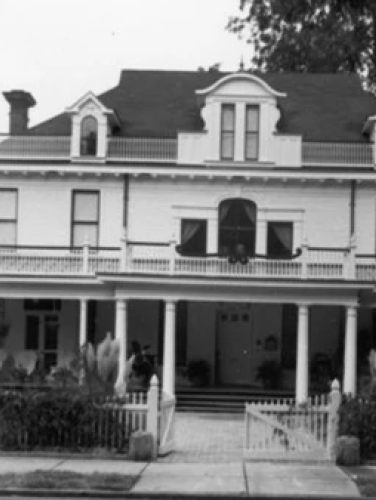
Villalonga-Alexander House
(ca. 1901)
Designed by noted local architect C. C. Hook, the Villalonga-Alexander House is Dilworth’s largest remaining private residence.
301 E Park Ave, Charlotte, NC 28203
The Villalonga-Alexander House is the largest remaining private residence in Dilworth, Charlotte’s first streetcar suburb. The Colonial Revival style two-and-one-half story frame house was constructed for John L. Villalonga, president and treasurer of the Charlotte Roof and Paving Company who also served as president of the Charlotte Brick Company, and his wife Constance M. Villalonga. The Villalongas were active in community; John was a member of the Vestry of St. Peter’s Episcopal Church, and Constance participated in the activities of the Saturday Afternoon Club, a prestigious women’s organization of that era. Their home was designed by Charles Christian Hook (1870-1938), Charlotte’s first resident professional architect, who is credited with introducing the Colonial Revival style into the city’s built environment. During the house’s construction, local newspapers described the residence as “one of the handsomest and most complete houses in Charlotte.”
Property Quick Links
Hook moved to Charlotte in 1891 to teach mechanical drawing in the Charlotte Graded School. He was hired within one year of his arrival by the Charlotte Consolidated Construction Company to design houses for its Dilworth development. Over his career, Hook designed some 800 to 1,000 homes and buildings across the Carolinas, including Charlotte’s U.S. Post Office and Courthouse, Charlotte City Hall, the Carolina Theater, three local fire stations, and several buildings on college campuses across North Carolina (including the Chapel Hill and Greensboro campuses of the University of North Carolina, Davidson College, and N.C. State, Duke, and Queens Universities).
In 1903, the Villalongas moved to New York City, selling their Dilworth home to Robert O. Alexander (1864-1926), a native of Sampson County, North Carolina, who had most recently lived and worked in Louisiana as a cotton broker. He continued to be quite successful in that profession in Charlotte for over twenty years, becoming regarded as one of the state’s best authorities on staple cotton. A deeply religious man, Robert acquired and developed large tracts of land around Black Mountain, North Carolina, using some portion of those holdings to develop the Presbyterian Assembly Grounds at nearby Montreat. He lived in the Dilworth home with wife May Herdon Alexander (1876-1958) and their seven children until Robert’s death in 1926. May continued to live in the house until 1936, when the federal government foreclosed a mortgage which it held on the property. She rented a room in an apartment house next door and lived there until her death in 1958.
Julian Elwin Dasher (1916-1983) and his two sisters, Ouida and Doris (1904-1993 and 1914-2007, respectively) purchased the Villalonga-Alexander House in 1938. They granted a life estate in the property to their mother, Clara E. Dasher (1884-1953). The younger Dashers and their spouses resided in the house, and Clara Dasher began to rent rooms to boarders, continuing that practice until her death in 1953. Ouida Dasher Brown and her husband James Arthur Brown (1887-1964) then assumed responsibility for managing the property. In March 1948, much of central interior of the Villalonga-Alexander House was destroyed by fire, including the roof and dormers. The Dashers were forced to live in a small house on Cleveland Avenue while extensive repairs were made to the main house. Following her husband’s death, Ouida continued to live in the house and rent rooms to boarders. The Villalonga-Alexander House has most recently been used as office space.

